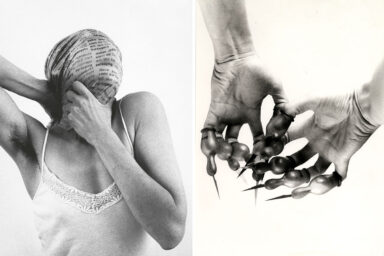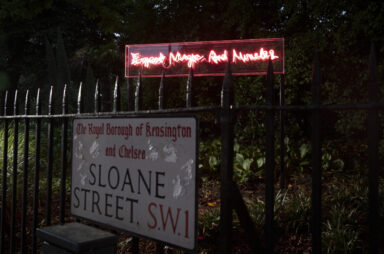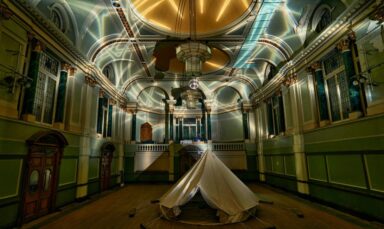Discover the hidden faces of Iranian art, design, and culture in this new extensive showcase retracing the history and cultural legacy of one of the world’s oldest civilisations — on display at London’s V&A until September 12
Words by: Gilda Bruno
The first UK exhibition in 90 years to explore Iran’s historic journey from 3,000 BC to the present day, Epic Iran presents visitors with over 300 rarely seen objects from ancient, Islamic, and contemporary Persia in a celebration of the country’s cultural and artistic richness. Organised by London’s Victoria and Albert Museum in collaboration with the Iran Heritage Foundation and the Sarikhani Collection, the exhibition draws from the V&A collection as well as national and international loans to narrate the myriad of facets of Iranian identity through a range of mediums, including sculpture, ceramics and carpets, textiles, photography, and film.
Turning the spotlight onto a cradle of civilisation known for its complex historic culture, vibrantly-coloured architectural masterpieces, myths, poetry, and millennia-long traditions, Epic Iran challenges the trivialising media portrayal of today’s Persia leaving the floor to the country’s prismatic and multigenerational artistic expressions. From the Cyrus Cylinder and intricate illuminated manuscripts of the Shahnameh, to ten-metre-long paintings of Isfahan tilework, Shirin Neshat’s powerful two-screen video installation Turbulent, and Shirin Aliabadi’s iconic photograph of a young woman blowing bubblegum.

Sirak Melkonian, Veiled Woman, 1957 © Sirak Melkonian. Photo: Victoria and Albert Museum, London. Exhibition section: Modern and Contemporary: New Departures. Epic Iran at the Victoria and Albert Museum, London, 29 May–12 September 2021.
In a conversation with Collectible DRY, Sarah Piram, V&A Project Curator, stressed how the showcase succeeds in providing the public with “a fresh perspective on a country that is often seen through a different lens, with its great artistic tradition remaining poorly known in the international community.” “Epic Iran is particularly relevant to the V&A as the world’s leading museum of art, design, and performance,” Piram explained.
“We have one of the most impressive collections of Iranian art and design from the medieval and modern periods. Furthermore, the exhibition approaches ancient Iranian art and contemporary creations, providing significant context to the cultural history and legacy of the country. The last major UK showcase covering 5,000 years of Iran’s artistic heritage was in 1931 at the Royal Academy in London. Many great discoveries have been made in 90 years, and this is exactly what we would like to reflect on with this exhibition.”
Originally scheduled to open in October 2020, Epic Iran was postponed due to COVID-19 restrictions eventually unveiling itself to on-site visitors starting from May 29. According to V&A Project Curator Piram, the pandemic was definitely one of the most challenging aspects in the development of the show. Despite the initial obstacles to the making of the exhibition, Epic Iran was fueled by “inspiring curatorial meetings and discussions,” something that facilitated both its coming-to-life and positive reception.

Horoscope of Iskandar Sultan, 1411. Courtesy Wellcome Collection.
Exhibition section: Change of Faith. Epic Iran at the Victoria and Albert Museum, London, 29 May–12 September 2021.
Featuring 10 different sections spread within a city-like immersive design, complete with a gatehouse, a palace, a library, and gardens, the exhibition takes the public on a journey through the treasures and secrets of the Persian world transporting visitors to a whole new different reality.
Elegantly curated so as to make each piece on display stand out from the rest of the show, Epic Iran spotlights artworks and heirlooms from different moments in Iranian history — including the Persian Empire and the Islamic Revolution — serving as irrefutable proof of the country’s multimillennial cultural and aesthetic ferment.
“This exhibition offers a rare opportunity to look at Iran as a single civilisation over 5,000 years,” Tim Stanley, co-curator of Epic Iran, said in a statement emphasising the relevance of the show for the V&A audience. “Objects and expertise have come together to tell one of the world’s great stories in art, design, and culture,” he continued.

Qaran Unhorses Barman, a folio from the Shahnameh of Shah Tahmasp, Tabriz, about 1523-35. The Sarikhani Collection, I.MS.4025. Photo: © The Sarikhani Collection Exhibition section: The Book of Kings. Epic Iran at the Victoria and Albert Museum, London, 29 May–12 September 2021.
“In the Islamic period, political power in Iran was recast in many different forms, but an overarching sense of history and a deep devotion to Persian literature survived the turmoil of events. In 1501 the Imami form of Shi’ism became Iran’s official religion, giving the population a unifying set of beliefs that set them apart from their neighbours. Shared beliefs, memories of a glorious past, and joy in Persian poetry are still a vital part of life in Iran today.”
Quoting Piram’s own words, the mounting of the show was guided by one simple principle, less is more. “Each room sounds like an exhibition of its own,” she explained to Collectible DRY.
“We did our best to keep a real harmony in the space, working closely with the exhibition designers, Gort Scott. They conceived the exhibition as a city, and we conceived the exhibition as a continuous story of an amazing civilisation. […] All objects on display were created in the context of a changing society and world around them, at separate times. We hope everyone can feel emotion throughout their visit, just as we did in the making of this exhibition.”
You can visit Epic Iran at the Victoria and Albert Museum, London, until September 12, 2021.


